Japan Pesticide Market Size
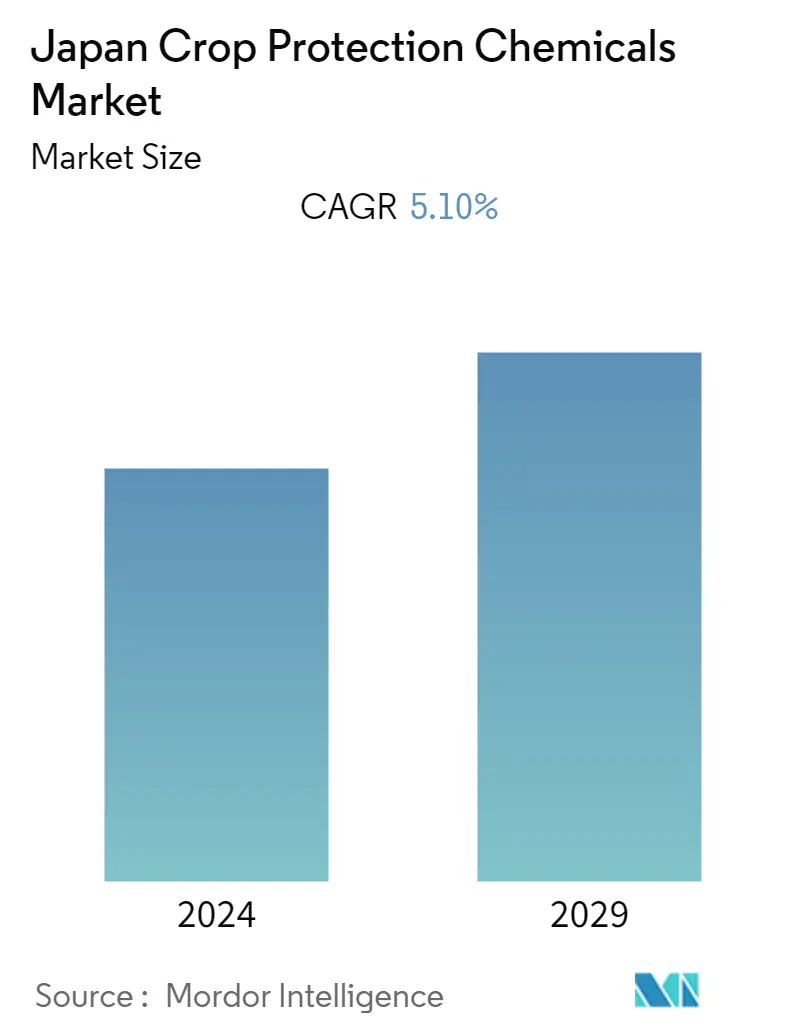
| Study Period | 2019 - 2029 |
| Base Year For Estimation | 2023 |
| Forecast Data Period | 2024 - 2029 |
| Historical Data Period | 2019 - 2022 |
| CAGR | 5.10 % |
| Market Concentration | High |
Major Players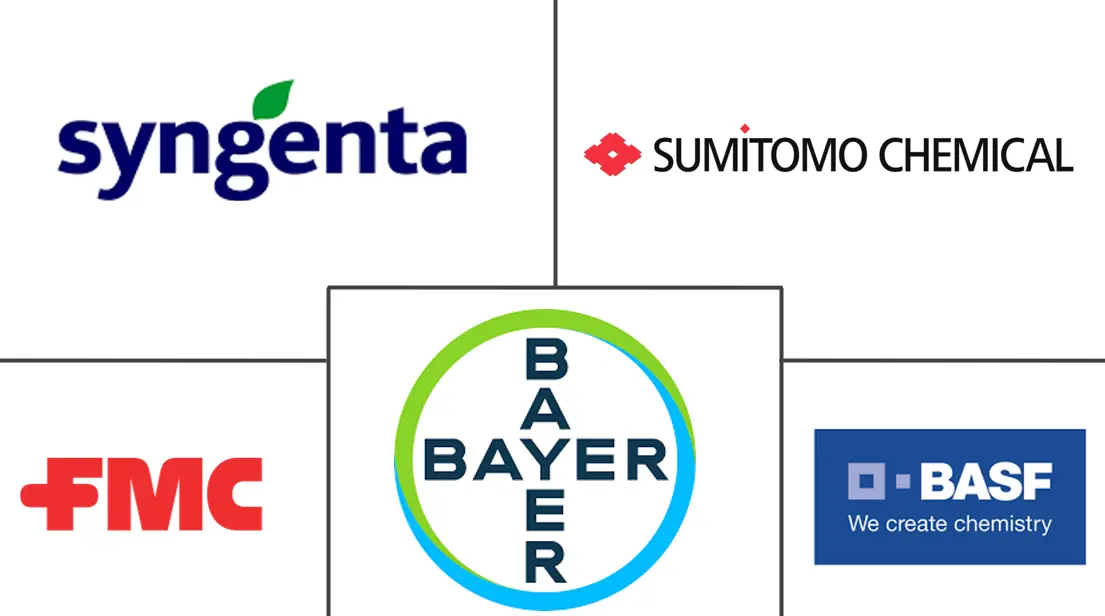
*Disclaimer: Major Players sorted in no particular order |
Japan Pesticide Market Analysis
The Japan Crop Protection Chemicals Market is projected to register a CAGR of 5.1% during the forecast period.
- The Japanese market for crop protection chemicals has continued to grow over the past few years and is majorly dominated by foreign players with their wide range of products. Insecticides, herbicides, and pesticides are the majorly used crop protection chemicals because of the high percentage of grains in the cultivated area and the considerable importance given to gardening in the region. According to the FAO, the agricultural usage of pesticides accounted for 51,970 metric tons in 2020.
- Crops like rice, soybean, wheat, barley, fruits, and vegetables are largely grown in Japan, accounting for the major usage of crop protection chemicals in the region. In spite of the small population and land area, Japan was a significant market for pesticides, occupying a prominent share in the Asia-Pacific region. The country has the highest pesticide usage per hectare of any other country in the world at approximately 12 kg /hectare.
- The expansion in the adoption of biopesticides and favorable government policies supporting the development of new innovative crop protection chemicals are some factors driving the market growth for Japanese crop protection chemicals. In March 2021, The Agriculture, Forestry, and Fisheries Ministry aimed to create a sustainable production system for farm products that do not rely solely on the use of chemical pesticides in the country. Japan's farm ministry aimed a new strategy to promote eco-friendly approaches in the agriculture, forestry, and fisheries industries, including a goal of reducing the usage of chemical pesticides by half from the current level by 2050.
Japan Pesticide Market Trends
This section covers the major market trends shaping the Japan Crop Protection Chemicals Market according to our research experts:
Increase in Grains and Cereals Production is Driving the Market
Japan is one of the largest producers of grain and cereals and is ranked the 12th largest producer of rice in the world. Grain and cereal products are of strategic importance in the whole world economy, also in Poland. They are essential ingredients of food; they are used in distilling, brewing, milling, and the industrial, energy, and pharmaceutical sectors.
Cereals such as rice, wheat, corn, barley, millet, and oats are the major crops grown in the country. According to the Food and Agriculture Organization of the United Nations (FAO) statistics, the production of cereals increased from 11,685.5 thousand hectares in 2020 to 11,898.8 thousand hectares in 2021. This, in turn, explains their predominance in the total volume of plant protection chemicals in the country.
The most important active substance used on this crop includes pesticides Cyromazine and Fenitrothion. With extensive cultivation of grains and cereals carried out across various parts of the country, the pesticide market application on grains and cereals is projected to grow during the forecast period. The Government of Japan (GOJ) has proposed changes to the Maximum Residual Limits (MRLs) for Oxadiazon, Dimethenamid, Tebufenozide, Pyributicarb and Metaldehyde, as well as the maximum level for cadmium in rice.
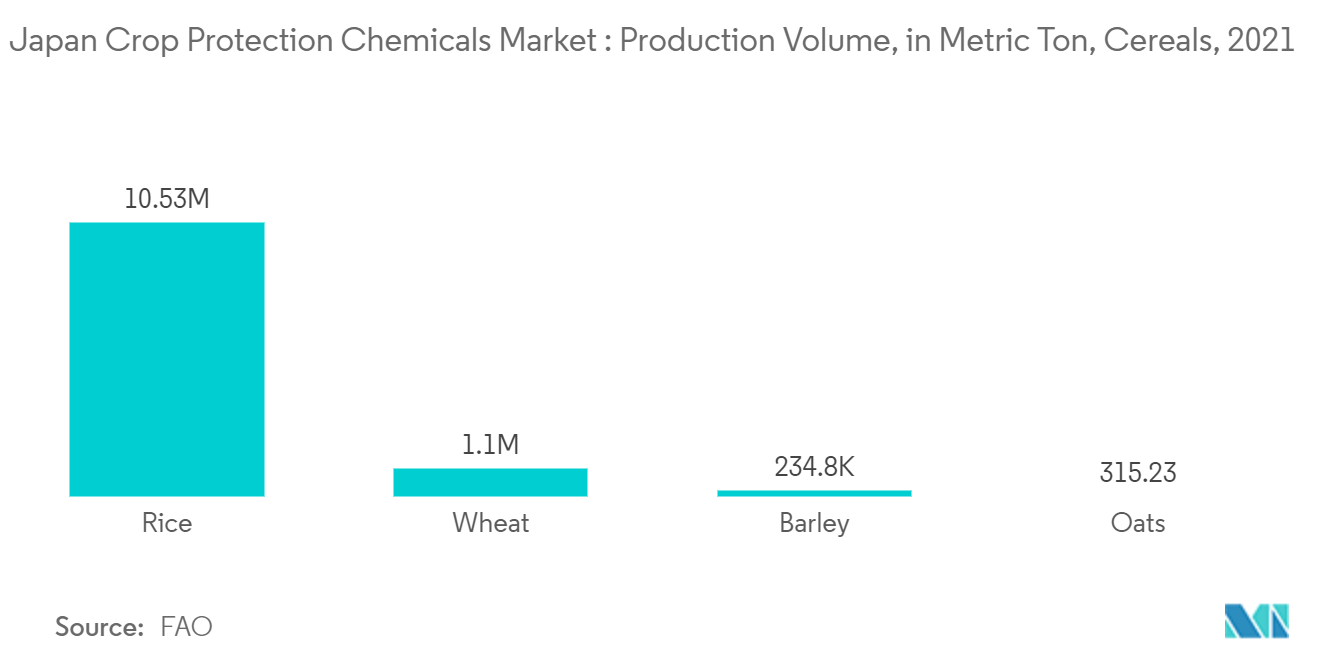
Insecticides Dominate the Market
Insecticide is an agent that destroys one or more species of insects. The ease of application is a big advantage of chemical insecticides over mechanical pest control methods. This also helps save labor costs. Chemical companies are taking advantage of Japan's weak laws on pesticide use by selling a wide variety of broad-spectrum pesticides for use in rice farming, including neonicotinoids banned in other countries. But other pesticide types with similarly devastating effects on aquatic ecosystems continue to be sold and promoted, such as Trebon, a synthetic pyrethroid sold by Mitsui Chemicals, and Prince, containing fipronil, a phenylpyrazole sold by BASF.
According to information provided by the Japanese NGO Act Beyond Trust, five main companies, Bayer, BASF, and Syngenta from Europe and Sumitomo Chemical and Mitsui Chemicals from Japan, manufacture and sell rice-field insecticides in Japan. With efforts aimed at reducing unnecessary utilization of chemical insecticides and comparatively higher use of bio-insecticides, the Japanese insecticide market is expected to witness healthy growth during the forecast period, primarily due to increased demand for biological insecticides.
Additionally, Mitsui Chemicals promoted dinotefuran as a featured product in its Corporate Social Responsibility (CSR) report for the year to 31 March 2018, stating that agriculture was expanding due to growing demand amid a rising global population and economic development in emerging countries.
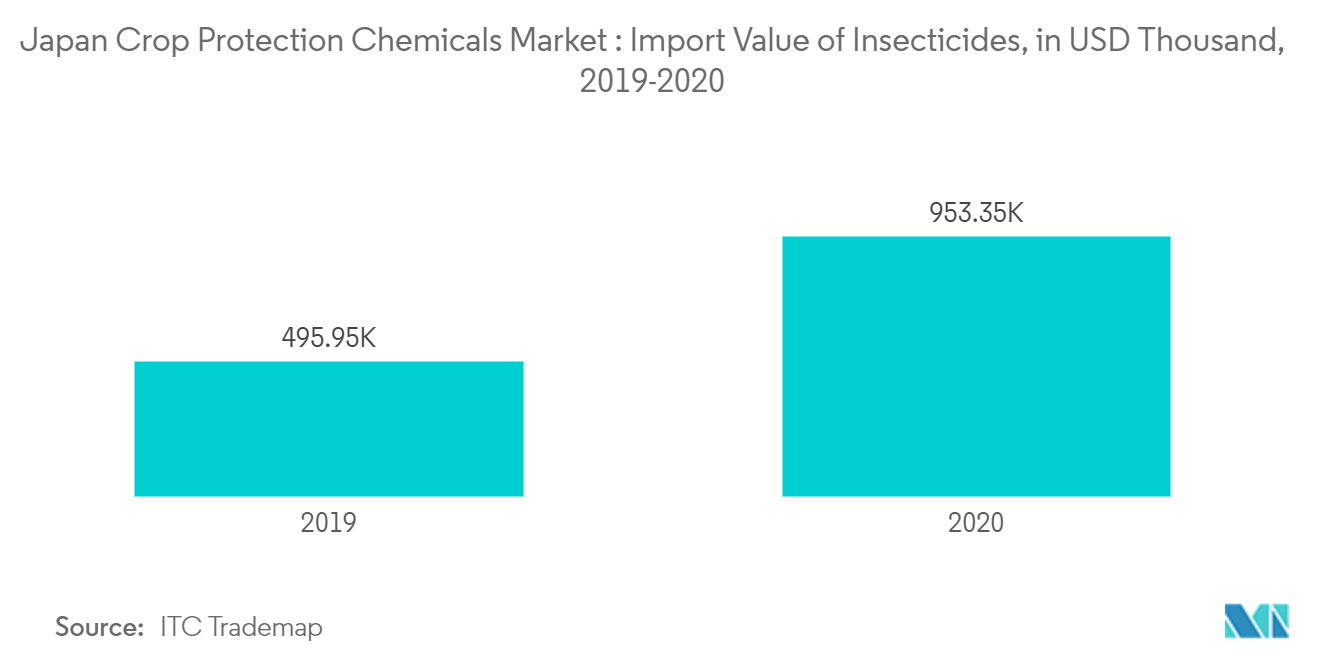
Japan Pesticide Industry Overview
The Japanese crop protection chemicals market is consolidated, with key players occupying the major market share. Some notable players operating in the market include Bayer, BASF SE, Syngenta AG, FMC Corporation, UPL Limited (Arysta LifeScience), and Sumitomo Chemical Co. Ltd. New product launches, partnerships, and acquisitions are the major strategies adopted by the leading companies in the market in the country. Along with innovations and expansions, investments in R&D and developing novel product portfolios are likely to be crucial strategies in the coming years.
Japan Pesticide Market Leaders
-
Bayer CropScience AG
-
FMC Corporation
-
Syngenta CropProtection AG
-
Sumitomo Chemical Co., Ltd.
-
BASF SE
*Disclaimer: Major Players sorted in no particular order
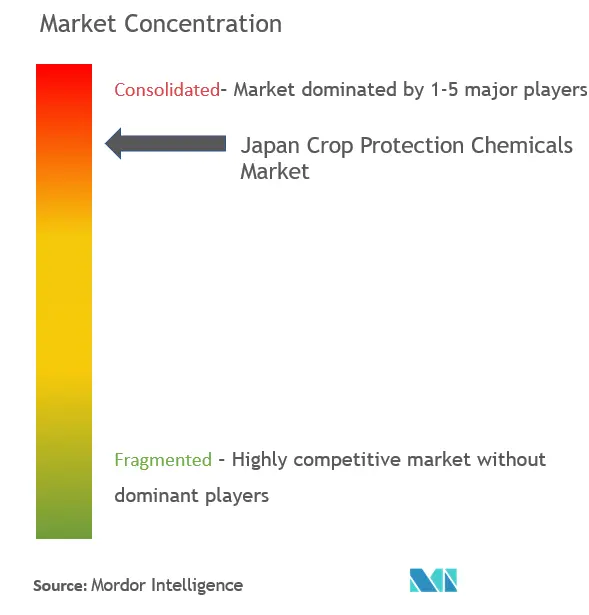
Japan Pesticide Market News
- Apr 2022: Nissan Chemical Corporation and Insecticides (India) Ltd collaborated to launch two products, namely Shinwa, a novel insecticide by Nissan Chemical Corporation, Japan, and Izuki, a combination fungicide in the Indian and Japanese agrochemical market.
- May 2021: UPL Ltd announced that its subsidiary entered into a license agreement with a Japanese company, Meiji Seika Pharma Co. Ltd, for exclusive access to Flupyrimin for rice in Southeast Asian countries, including Japan and Indonesia.
Japan Pesticide Market Report - Table of Contents
1. INTRODUCTION
- 1.1 Study Assumptions & Market Definition
- 1.2 Scope of the Study
2. RESEARCH METHODOLOGY
3. EXECUTIVE SUMMARY
4. MARKET DYNAMICS
- 4.1 Market Overview
- 4.2 Market Drivers
- 4.3 Market Restraints
-
4.4 Porter's Five Forces Analysis
- 4.4.1 Bargaining Power of Suppliers
- 4.4.2 Bargaining Power of Buyers
- 4.4.3 Threat of New Entrants
- 4.4.4 Threat of Substitutes
- 4.4.5 Intensity of Competitive Rivalry
5. MARKET SEGMENTATION
-
5.1 Origin
- 5.1.1 Synthetic
- 5.1.2 Bio-based
-
5.2 Type
- 5.2.1 Herbicide
- 5.2.2 Fungicide
- 5.2.3 Insecticide
- 5.2.4 Other Types
-
5.3 Application
- 5.3.1 Grains and Cereals
- 5.3.2 Pulses and Oilseeds
- 5.3.3 Fruits and Vegetables
- 5.3.4 Commercial Crops
- 5.3.5 Other Applications
6. COMPETITIVE LANDSCAPE
- 6.1 Most Adopted Strategies
- 6.2 Market Share Analysis
-
6.3 Company Profiles
- 6.3.1 Bayer CropScience AG
- 6.3.2 FMC Corporation
- 6.3.3 Syngenta CropProtection AG
- 6.3.4 Kumiai Chemical Industry Co. Ltd
- 6.3.5 Sumitomo Chemical Co. Ltd
- 6.3.6 Nissan Chemical Corporation
- 6.3.7 Mitsui Chemicals Agro Inc.
- 6.3.8 BASF SE
- 6.3.9 UPL Limited (Arysta LifeScience)
- *List Not Exhaustive
7. MARKET OPPORTUNITIES AND FUTURE TRENDS
** Subject To AvailablityJapan Pesticide Industry Segmentation
Crop protection chemicals have been defined for the purpose of this report as commercially manufactured agrochemicals used to prevent crop destruction by pests, diseases, and weeds, thereby improving crop yield and quality. Agrochemicals used by farmers and large commercial growers in crops and non-crop agricultural practices are included in the market studied. The Japan Crop Protection Chemicals Market is Segmented by Origin (Synthetic and Bio-based), Type (Herbicide, Fungicide, Insecticide, Nematicide, Molluscicide, and Other Types), and Application (Grains and Cereals, Pulses and Oilseeds, Fruits and Vegetables, Commercial Crops, and Other Applications). The report offers the market size and forecasts for value in (USD million) for all the above segments.
| Origin | Synthetic |
| Bio-based | |
| Type | Herbicide |
| Fungicide | |
| Insecticide | |
| Other Types | |
| Application | Grains and Cereals |
| Pulses and Oilseeds | |
| Fruits and Vegetables | |
| Commercial Crops | |
| Other Applications |
Japan Pesticide Market Research FAQs
What is the current Japan Crop Protection Chemicals Market size?
The Japan Crop Protection Chemicals Market is projected to register a CAGR of 5.10% during the forecast period (2024-2029)
Who are the key players in Japan Crop Protection Chemicals Market?
Bayer CropScience AG, FMC Corporation, Syngenta CropProtection AG, Sumitomo Chemical Co., Ltd. and BASF SE are the major companies operating in the Japan Crop Protection Chemicals Market.
What years does this Japan Crop Protection Chemicals Market cover?
The report covers the Japan Crop Protection Chemicals Market historical market size for years: 2019, 2020, 2021, 2022 and 2023. The report also forecasts the Japan Crop Protection Chemicals Market size for years: 2024, 2025, 2026, 2027, 2028 and 2029.
Japan Pesticide Industry Report
Statistics for the 2024 Japan Pesticide market share, size and revenue growth rate, created by Mordor Intelligence™ Industry Reports. Japan Pesticide analysis includes a market forecast outlook 2029 and historical overview. Get a sample of this industry analysis as a free report PDF download.



